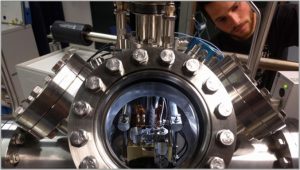Nanotechnology for solar energy conversion:
smart materials for the building envelope

Research topics
- Smart selective solar absorber coatings based on reversible semiconductor-to-metal transition
- Solid-ion-conductors for durable electrochromic windows
- Metallic micro-/nanomeshes for transparent conductive layers
- Highly durable selective solar absorber coatings for solar thermal collectors and electricity generation by concentrated solar power (CSP)
- Frequency-selective surfaces by nanosecond laser-ablation
- Optical coatings on solar glass for photovoltaic modules and solar thermal collectors – development of colored glazing for solar facades and solar roofing
- Energy efficiency of public transportation
- Quantum dot solar concentrators for building integrated photovoltaics
- Angular dependent optical and thermal properties of advanced architectural glazing
- Optical microstructures for advanced architectural glazing
- Building integration of our novel solar technologies
Selected references
[BOU2021] Bouvard O., Burnier L., Lagier M., Schüler A., Strong coloration of nanoporous tungsten oxides by in-vacuo lithiation for all-solid-state electrochromic devices, Thin Solid Films, 2021, 730, 138700. https://doi.org/10.1016/j.tsf.2021.138700
[BOU2017] Bouvard, O., Lanini, M., Burnier, L., Witte, R., Cuttat, B., Salvadè, A., Schüler, A., Structured transparent low emissivity coatings with high microwave transmission, (2017) Applied Physics A: Materials Science and Processing, 123 (1), art. no. 66.
https://doi.org/10.1007/s00339-016-0701-8
[BUR2023] Burnier L., Jamaly N., Delaporte H., Durussel S., Fleury J., Schüler, A., Energy saving glazing with high MIMO performance, manuscript in preparation
[FLE2023] Fleury, J., Burnier, L., Lagier, M., Shukla, S., Manwani K., Panda, E., Schüler, A., Electrochromic device with hierarchical metal mesh electrodes: Transmittance switching in the full spectral range of solar radiation, Solar Energy Materials and Solar Cells 257 (2023) 112345 https://doi.org/10.1016/j.solmat.2023.112345
[FLE2022] Fleury, J., Burnier, L., Schüler, A., Electronic properties and ion migration of in vacuo lithiated nanoporous WO3:Mo thin films, Journal of Applied Physics, 2022, 131(1), 015301. https://doi.org/10.1063/5.0074455
[FLE2020] Fleury, J., Lanini, M., Pose, C., Burnier, L., Salvadè, A., Zimmermann, E., Genoud, C., Schüler, A., Wide band-pass FSS with reduced periodicity for energy efficient windows at higher frequencies, Applied Physics A: Materials Science and Processing, 2020, 126(6), 417. https://doi.org/10.1007/s00339-020-03547-w
[FLO2022] Florio, P., Tendon, X., Fleury, J., Costantini C. , Schueler A., Scartezzini J.-L., Performance Assessment of a nZEB Carbon Neutral Living/Office Space and Its Integration into a District Energy-Hub, Energies 2022, 15(3), 793 https://doi.org/10.3390/en15030793
[GON2018] Gong, J., Delaunay, A., Kostro, A., Schüler A., Development of a novel mechanical micro-engraving method for the high-aspect-ratio microstructures of an advanced window system, (2018) Microelectronic Engineering, 191, pp. 48-53.
https://doi.org/10.1016/j.mee.2018.01.032
[JOL2017] Jolissaint, N., Hanbali, R., Hadorn, J.-C., Schüler, A., Colored solar façades for buildings, (2017) Energy Procedia, 122, pp. 175-180. Describes our novel PV technology integrated to building façades. https://doi.org/10.1016/j.egypro.2017.07.340
[KRA2022a] Krammer, A., Matilainen, A., Pischow, K., Schüler, A., VO2:Ge based thermochromic solar absorber coatings, Solar Energy Materials and Solar Cells, 2022, 240, 111680. https://doi.org/10.1016/j.solmat.2022.111680
[KRA2022b] Krammer, A., Lagier, M., Schüler, A., In-line electronic and structural characterization of reactively sputtered Cu-Co-Mn black spinel oxides, Journal of Vacuum Science and Technology A: Vacuum, Surfaces and Films, 2021, 39(5), 053411. https://doi.org/10.1116/6.0001120
[KRA2017] Krammer, A., Magrez, A., Vitale, W.A., Mocny, P., Jeanneret, P., Guibert, E., Whitlow, H.J., Ionescu, A.M., Schüler, A., Elevated transition temperature in Ge doped VO2 thin films, (2017) Journal of Applied Physics, 122 (4), art. no. 045304.
https://doi.org/10.1063/1.4995965
[LAG2021] Lagier, M., Bertinotti, A., Bouvard, O., Burnier, L., Schüler, A., Optical properties of in vacuo lithiated nanoporous WO3:Mo thin films as determined by spectroscopic ellipsometry, Optical Materials, 2021, 117, 111091. https://doi.org/10.1016/j.optmat.2021.111091
[NI2023] Ni, W., Meibom, J.L., Hassan, N.U., Chang, M., Chiuan, Y.-C., Krammer, A., Sun, S., Zheng, Y., Bai, L., Ma, W., Lee, S., Jin, S., Luterbacher, J.S., Schüler, A., Chen, H.M., Mustain, W.E., Hu, X., Synergistic interactions between PtRu catalyst and nitrogen-doped carbon support boost hydrogen oxidation, Nature Catalysis (2023). https://www.nature.com/articles/s41929-023-01007-1
[NIK2022] Nikoo, M.S., Reza Soleimanzadeh, R., Krammer, A., Marega, G.M., Yunkyu Park, Y., Son, J., Schueler, A., Andras Kis, A., Moll, P.J.W., Matioli, E., Electrical control of glass-like dynamics in vanadium dioxide for data storage and processing, Nature Elecronics, 2022, Vol. 5, 96–603
https://doi.org/10.1038/s41928-022-00812-z